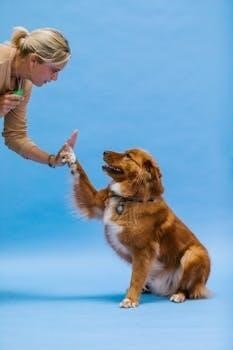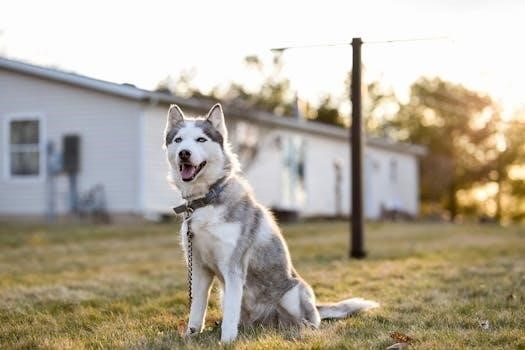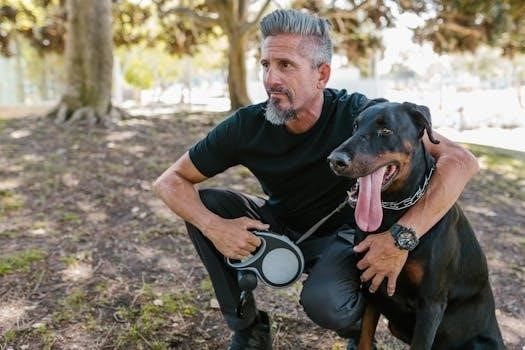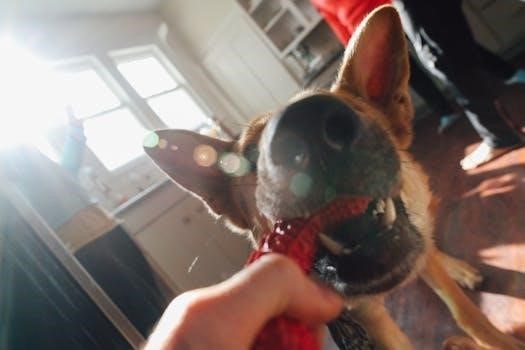Dog Training Guide PDF⁚ A Comprehensive Overview
This guide offers a broad look at dog training‚ emphasizing the importance of clear communication and positive reinforcement. It highlights key training aspects‚ from basic commands to advanced skills‚ ensuring a well-behaved and happy dog. This also touches on different training methods and their effectiveness.
Effective dog training relies on several core principles. Firstly‚ consistency is key; always use the same cues and commands. Secondly‚ understand that dogs learn best when training sessions are fun and engaging‚ so keep them short‚ typically around 3-5 minutes‚ and always end on a positive note. It’s crucial to maintain your dog on a leash‚ unless a specific off-leash exercise is required‚ and prevent interactions with other dogs before or during training to minimize distractions. Also‚ avoid feeding your dog for at least four hours prior to training to ensure treats are more enticing. Use verbal cues only once‚ so your dog learns to respond promptly. Being enthusiastic with praise helps your dog understand they’ve done well. Remember‚ proper training fosters effective communication and strengthens the bond between you and your dog. These fundamental practices lay the groundwork for successful training sessions.
Basic Training Concepts⁚ Short Sessions and Clear Cues
The foundation of successful dog training lies in the application of basic concepts‚ primarily focusing on short training sessions and the use of clear cues. Short sessions‚ lasting approximately 3-5 minutes‚ help maintain the dog’s focus and prevent boredom. Longer sessions can lead to frustration for both the dog and the trainer‚ hindering progress. Clear‚ concise verbal cues are essential; say a command only once‚ ensuring the dog learns to respond the first time. Consistency in these cues is also crucial‚ avoiding confusion for the dog. Each training session should conclude with the dog performing a task successfully‚ reinforcing positive behavior and building confidence. Using enthusiastic praise and positive reinforcement when the dog gets it right is very important. This approach promotes effective communication and accelerates the learning process. Remember these concepts are fundamental to establishing a strong training foundation.
The Importance of Positive Reinforcement in Dog Training
Positive reinforcement is a cornerstone of effective dog training‚ focusing on rewarding desired behaviors to increase their frequency. Instead of punishing unwanted actions‚ this method encourages dogs to repeat actions that elicit praise‚ treats‚ or other forms of positive feedback. This approach not only makes training more enjoyable but also strengthens the bond between dog and owner. When a dog performs a wanted behavior‚ a short‚ brief word or sound should be used to signal the success. This creates a positive association with the action. The use of treats‚ verbal praise‚ and physical affection can all serve as effective reinforcers. Consistency in using these methods helps the dog understand what you expect‚ creating a learning environment that is both fun and rewarding. Positive reinforcement fosters a happy‚ well-mannered dog‚ and builds effective communication skills.
Essential Commands⁚ Sit‚ Stay‚ Come‚ Down‚ Heel
Mastering essential commands like “Sit‚” “Stay‚” “Come‚” “Down‚” and “Heel” is fundamental for a well-behaved dog. These commands not only ensure your dog’s safety but also facilitate better communication between you and your pet. “Sit” is often the first command taught‚ forming the basis for other training exercises. “Stay” teaches your dog self-control and patience‚ while “Come” is crucial for recall in various situations. The “Down” command is useful for promoting calmness and is often a precursor to other advanced behaviors. “Heel” focuses on walking politely on a leash‚ preventing pulling and allowing for more enjoyable walks. These five basic commands are the foundation for future training‚ providing a strong base for more advanced behaviors and overall obedience. Consistent practice and positive reinforcement are key to successful command learning.
Using Treats and Praise Effectively During Training

Effective dog training relies heavily on the strategic use of treats and praise as positive reinforcement. Treats should be small‚ high-value rewards that motivate your dog‚ and can even include their regular food. The timing of the treat is crucial; deliver it immediately after the desired behavior to create a clear association. Pairing treats with verbal praise‚ such as “Good dog!” or “Yes!”‚ further reinforces positive actions. Initially‚ praise should be enthusiastic to ensure your dog understands they’ve done well. As training progresses‚ you can gradually reduce the reliance on treats‚ maintaining the praise as a primary motivator. Avoid using treats as lures; instead‚ use them as rewards for correct behavior. Remember‚ the goal is to create a positive and enjoyable training experience‚ so your dog is eager to learn. Consistency is key‚ and a varied approach with both treats and praise will yield the best results.

Clicker Training⁚ Speeding Up the Learning Process
Clicker training is a highly effective method that uses a distinct “click” sound to mark the precise moment your dog performs the desired behavior‚ thereby accelerating the learning process. The clicker acts as a bridge between the action and the reward‚ making it crystal clear to your dog what they are being praised for. Start by associating the click with a treat; click‚ then immediately give the treat. After several repetitions‚ your dog will understand that the click means a reward is coming. Once this association is made‚ use the clicker to mark correct behaviors during training. The click should be followed by a treat or praise. This method is particularly useful for shaping complex behaviors‚ as the click helps break down the task into smaller‚ more manageable steps. The consistency and precision of the click make it a powerful tool for effective dog training.
Potty Training with Bells⁚ A Helpful Tool
Potty training with bells is a useful method for teaching your dog to communicate their need to go outside. The concept is simple⁚ hang a set of bells on the door your dog uses to go outside. Each time you take your dog out for a potty break‚ gently encourage them to touch the bells with their nose or paw‚ rewarding them immediately. Consistency is key; you must repeat this process every time you go outside. Over time‚ your dog will associate the sound of the bells with going outside to relieve themselves. Once they make this connection‚ they will start ringing the bells themselves when they need to go out. This system provides a clear signal that you can easily recognize‚ helping prevent accidents inside. This is a great option for dogs that don’t naturally bark or whine when they need to go outside. Combining this with regular bathroom breaks will lead to potty training success.

The Benefits of Dog Training Classes
Dog training classes offer numerous advantages for both you and your canine companion. Firstly‚ they provide a structured learning environment that can help you learn to train your dog effectively. In a class setting‚ your dog will be exposed to various distractions‚ teaching them to maintain focus even in stimulating situations. Furthermore‚ you’ll learn from experienced trainers who can offer personalized guidance and address specific challenges; Training classes also allow your dog to socialize with other dogs‚ a crucial aspect of their development. This promotes well-rounded behavior and reduces anxiety when encountering other animals. Beyond the skills taught‚ classes foster a stronger bond between you and your dog through shared learning experiences. Moreover‚ they help you establish clear communication‚ leading to a more harmonious relationship. Finally‚ classes are a great way to address behavioral issues early on and prevent them from escalating. Investing in training classes is an investment in your dog’s future and your relationship with them.
Training in Different Environments and Socialization
Training your dog solely at home may not prepare them for real-world situations. It’s crucial to extend training into various environments to ensure they respond reliably in diverse settings. Start with familiar places like your backyard‚ then gradually move to less controlled environments such as parks and streets. This helps your dog generalize their training‚ understanding that commands apply regardless of the location. Socialization is an equally important aspect of training‚ as it teaches your dog to interact appropriately with other dogs and people. Exposure to different sights‚ sounds‚ and smells builds their confidence and prevents fear-based behaviors. Controlled socialization sessions‚ like those found in training classes‚ help your dog learn proper interaction etiquette. These experiences also allow you to observe your dog’s reactions and intervene when needed. By combining environmental training with socialization‚ you’re preparing your dog to be well-adjusted‚ confident‚ and adaptable members of your community. This not only enhances their safety and comfort but also ensures a more enjoyable experience for both of you.
Addressing Behavior Modification Needs
Behavior modification is crucial for dogs exhibiting unwanted behaviors like excessive barking‚ aggression‚ or separation anxiety. This involves identifying the root cause of the behavior‚ which often requires understanding a dog’s triggers and motivations. Instead of punishment‚ which can exacerbate the problem‚ behavior modification relies on positive reinforcement and counter-conditioning. This means rewarding desired behaviors and changing the dog’s emotional response to triggers. For example‚ if a dog is reactive to other dogs‚ you would gradually expose them to other dogs from a distance‚ rewarding calm behavior‚ slowly decreasing the distance as the dog becomes more comfortable. Consistency is key when modifying a dog’s behavior‚ as is patience. It’s important to avoid situations that may trigger the unwanted behavior in the initial stages of treatment. In more complex cases‚ seeking professional help from a certified dog trainer or a veterinary behaviorist is advisable. They can develop a personalized behavior modification plan tailored to the dog’s specific needs. It is also important to realize that behavior modification is an ongoing process‚ not a quick fix‚ and requires commitment from the owner.
Advanced Training⁚ Tricks and Useful Skills
Once your dog has mastered basic commands‚ you can move on to advanced training‚ which includes teaching tricks and more complex‚ useful skills. This can range from fun tricks like “play dead” or “roll over” to practical skills like retrieving specific items or going to a designated “bed” or “mat”. Advanced training not only provides mental stimulation for your dog but also strengthens the bond between you. To teach tricks‚ break them down into smaller steps and use positive reinforcement. Clicker training can be particularly effective for teaching complex behaviors. For useful skills‚ such as retrieving‚ start with simple tasks like fetching a toy and gradually increase the complexity. Consistent training and short‚ fun sessions are the key to success. Remember that every dog learns at a different pace‚ so be patient and celebrate small victories. Advanced training should be an enjoyable experience for both you and your dog‚ creating more opportunities for interaction and communication‚ and leading to a more well-rounded and confident companion. It offers a great way to maintain a dog’s engagement and mental sharpness.
Maintaining a Happy and Healthy Bond Through Training

Consistent training is not just about teaching commands; it’s a vital tool for nurturing a strong‚ healthy bond with your dog. Regular training sessions‚ even short ones‚ provide mental stimulation that keeps your dog engaged and happy. When you train‚ you’re actively communicating with your dog‚ building trust and understanding. Positive reinforcement methods‚ such as praise and treats‚ create a positive environment that fosters a stronger connection. The act of learning together enhances your dog’s confidence and strengthens the partnership between you. A well-trained dog is often a more relaxed and content dog‚ because they understand what’s expected of them. Continued training‚ even after your dog has learned the basics‚ offers ongoing opportunities for interaction and bonding. By incorporating training into your daily routine‚ you’re not just teaching commands‚ but also creating a deeper‚ more meaningful relationship built on respect‚ trust‚ and mutual enjoyment. This consistent engagement ensures a happy and fulfilling life together. This can be accomplished by continuing with advanced tricks and skills‚ or simply reviewing the basics from time to time.

Leave a Reply
You must be logged in to post a comment.